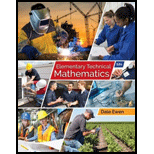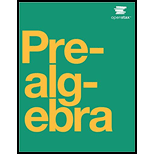
Elementary Technical Mathematics
12th Edition
ISBN: 9781337630580
Author: Dale Ewen
Publisher: Cengage Learning
expand_more
expand_more
format_list_bulleted
Concept explainers
Question
Chapter 16.8, Problem 26E
To determine
To calculate: The result of hexadecimal addition
Expert Solution & Answer
Want to see the full answer?
Check out a sample textbook solution
Students have asked these similar questions
Using the accompanying Accounting Professionals data to answer the following questions.
a. Find and interpret a 90% confidence interval for the mean years of service.
b. Find and interpret a 90% confidence interval for the proportion of employees who have a graduate degree.
view the Accounting Professionals data.
Employee Years of Service Graduate Degree?1 26 Y2 8 N3 10 N4 6 N5 23 N6 5 N7 8 Y8 5 N9 26 N10 14 Y11 10 N12 8 Y13 7 Y14 27 N15 16 Y16 17 N17 21 N18 9 Y19 9 N20 9 N
Question content area bottom
Part 1
a. A 90% confidence interval for the mean years of service is
(Use ascending order. Round to two decimal places as needed.)
Let the region R be the area enclosed by the function f(x) = ex — 1, the horizontal line y = -4 and
the vertical lines x = 0 and x = 3. Find the volume of the solid generated when the region R is revolved
about the line y = -4. You may use a calculator and round to the nearest thousandth.
20
15
10
5
y
I
I
I
|
I
+
-1.5
-1
-0.5
0.5
1
1.5
2
2.5
3
-5
I
-10
-15
I
+
I
I
T
I
I
+
-20
I
+
-25
I
I
I
-30
I
3.5
4
x
The joint probability function for the random variables X and Y is
y
0
1
2
P(X, Y) = x0 [3/28 9/28 3/281
=
13/14 3/14
2 1/28 0
0
0
Find Mx, My, E(XY), OXY.
Chapter 16 Solutions
Elementary Technical Mathematics
Ch. 16.1 - Change each binary number to decimal form: 11Ch. 16.1 - Prob. 2ECh. 16.1 - Prob. 3ECh. 16.1 - Prob. 4ECh. 16.1 - Prob. 5ECh. 16.1 - Prob. 6ECh. 16.1 - Prob. 7ECh. 16.1 - Prob. 8ECh. 16.1 - Prob. 9ECh. 16.1 - Prob. 10E
Ch. 16.1 - Prob. 11ECh. 16.1 - Prob. 12ECh. 16.1 - Prob. 13ECh. 16.1 - Prob. 14ECh. 16.1 - Prob. 15ECh. 16.1 - Prob. 16ECh. 16.1 - Change each binary number to decimal form:...Ch. 16.1 - Prob. 18ECh. 16.1 - Change each binary number to decimal form: 111111Ch. 16.1 - Prob. 20ECh. 16.2 - Prob. 1ECh. 16.2 - Prob. 2ECh. 16.2 - Prob. 3ECh. 16.2 - Prob. 4ECh. 16.2 - Prob. 5ECh. 16.2 - Prob. 6ECh. 16.2 - Prob. 7ECh. 16.2 - Prob. 8ECh. 16.2 - Prob. 9ECh. 16.2 - Prob. 10ECh. 16.2 - Prob. 11ECh. 16.2 - Prob. 12ECh. 16.2 - Prob. 13ECh. 16.2 - Prob. 14ECh. 16.2 - Prob. 15ECh. 16.2 - Add the following binary numbers and check your...Ch. 16.2 - Prob. 17ECh. 16.2 - Prob. 18ECh. 16.2 - Prob. 19ECh. 16.2 - Prob. 20ECh. 16.2 - Prob. 21ECh. 16.2 - Prob. 22ECh. 16.2 - Prob. 23ECh. 16.2 - Add the following binary numbers and check your...Ch. 16.2 - Prob. 25ECh. 16.2 - Prob. 26ECh. 16.2 - Add the following binary numbers and check your...Ch. 16.2 - Prob. 28ECh. 16.2 - Prob. 29ECh. 16.2 - Prob. 30ECh. 16.3 - Prob. 1ECh. 16.3 - Prob. 2ECh. 16.3 - Subtract the following binary numbers and check in...Ch. 16.3 - Prob. 4ECh. 16.3 - Subtract the following binary numbers and check in...Ch. 16.3 - Subtract the following binary numbers and check in...Ch. 16.3 - Prob. 7ECh. 16.3 - Prob. 8ECh. 16.3 - Prob. 9ECh. 16.3 - Subtract the following binary numbers and check in...Ch. 16.3 - Subtract the following binary numbers and check in...Ch. 16.3 - Prob. 12ECh. 16.3 - Prob. 13ECh. 16.3 - Prob. 14ECh. 16.3 - Subtract the following binary numbers and check in...Ch. 16.3 - Prob. 16ECh. 16.3 - Prob. 17ECh. 16.3 - Subtract the following binary numbers and check in...Ch. 16.3 - Prob. 19ECh. 16.3 - Prob. 20ECh. 16.3 - Prob. 21ECh. 16.3 - Prob. 22ECh. 16.3 - Prob. 23ECh. 16.3 - Prob. 24ECh. 16.3 - Prob. 25ECh. 16.3 - Prob. 26ECh. 16.3 - Prob. 27ECh. 16.3 - Prob. 28ECh. 16.3 - Prob. 29ECh. 16.3 - Use the 1s complement method to subtract the...Ch. 16.3 - Prob. 31ECh. 16.3 - Prob. 32ECh. 16.3 - Prob. 33ECh. 16.3 - Prob. 34ECh. 16.3 - Prob. 35ECh. 16.3 - Prob. 36ECh. 16.4 - Prob. 1ECh. 16.4 - Prob. 2ECh. 16.4 - Multiply the following binary numbers: 11010_Ch. 16.4 - Prob. 4ECh. 16.4 - Prob. 5ECh. 16.4 - Prob. 6ECh. 16.4 - Prob. 7ECh. 16.4 - Prob. 8ECh. 16.4 - Prob. 9ECh. 16.4 - Prob. 10ECh. 16.4 - Prob. 11ECh. 16.4 - Prob. 12ECh. 16.4 - Prob. 13ECh. 16.4 - Multiply the following binary numbers: 101101101_Ch. 16.4 - Prob. 15ECh. 16.4 - Prob. 16ECh. 16.4 - Prob. 17ECh. 16.4 - Prob. 18ECh. 16.4 - Prob. 19ECh. 16.4 - Prob. 20ECh. 16.5 - Prob. 1ECh. 16.5 - Prob. 2ECh. 16.5 - Prob. 3ECh. 16.5 - Prob. 4ECh. 16.5 - Prob. 5ECh. 16.5 - Prob. 6ECh. 16.5 - Prob. 7ECh. 16.5 - Prob. 8ECh. 16.5 - Prob. 9ECh. 16.5 - Prob. 10ECh. 16.5 - Prob. 11ECh. 16.5 - Prob. 12ECh. 16.5 - Prob. 13ECh. 16.5 - Prob. 14ECh. 16.5 - Prob. 15ECh. 16.5 - Prob. 16ECh. 16.5 - Prob. 17ECh. 16.5 - Prob. 18ECh. 16.5 - Prob. 19ECh. 16.5 - Prob. 20ECh. 16.6 - Prob. 1ECh. 16.6 - Prob. 2ECh. 16.6 - Prob. 3ECh. 16.6 - Prob. 4ECh. 16.6 - Prob. 5ECh. 16.6 - Prob. 6ECh. 16.6 - Prob. 7ECh. 16.6 - Prob. 8ECh. 16.6 - Prob. 9ECh. 16.6 - Prob. 10ECh. 16.6 - Prob. 11ECh. 16.6 - Prob. 12ECh. 16.6 - Prob. 13ECh. 16.6 - Prob. 14ECh. 16.6 - Prob. 15ECh. 16.6 - Prob. 16ECh. 16.6 - Prob. 17ECh. 16.6 - Prob. 18ECh. 16.6 - Prob. 19ECh. 16.6 - Change each binary number to decimal form:...Ch. 16.7 - Prob. 1ECh. 16.7 - Prob. 2ECh. 16.7 - Prob. 3ECh. 16.7 - Prob. 4ECh. 16.7 - Prob. 5ECh. 16.7 - Prob. 6ECh. 16.7 - Prob. 7ECh. 16.7 - Prob. 8ECh. 16.7 - Prob. 9ECh. 16.7 - Prob. 10ECh. 16.7 - Prob. 11ECh. 16.7 - Prob. 12ECh. 16.7 - Prob. 13ECh. 16.7 - Change each hexadecimal number to decimal form:...Ch. 16.7 - Prob. 15ECh. 16.7 - Prob. 16ECh. 16.7 - Prob. 17ECh. 16.7 - Prob. 18ECh. 16.7 - Prob. 19ECh. 16.7 - Prob. 20ECh. 16.7 - Prob. 21ECh. 16.7 - Prob. 22ECh. 16.7 - Prob. 23ECh. 16.7 - Prob. 24ECh. 16.7 - Prob. 25ECh. 16.7 - Prob. 26ECh. 16.7 - Prob. 27ECh. 16.7 - Prob. 28ECh. 16.7 - Prob. 29ECh. 16.7 - Prob. 30ECh. 16.8 - Prob. 1ECh. 16.8 - Prob. 2ECh. 16.8 - Prob. 3ECh. 16.8 - Prob. 4ECh. 16.8 - Prob. 5ECh. 16.8 - Prob. 6ECh. 16.8 - Prob. 7ECh. 16.8 - Prob. 8ECh. 16.8 - Prob. 9ECh. 16.8 - Prob. 10ECh. 16.8 - Prob. 11ECh. 16.8 - Prob. 12ECh. 16.8 - Prob. 13ECh. 16.8 - Prob. 14ECh. 16.8 - Prob. 15ECh. 16.8 - Prob. 16ECh. 16.8 - Prob. 17ECh. 16.8 - Prob. 18ECh. 16.8 - Prob. 19ECh. 16.8 - Prob. 20ECh. 16.8 - Prob. 21ECh. 16.8 - Prob. 22ECh. 16.8 - Prob. 23ECh. 16.8 - Prob. 24ECh. 16.8 - Prob. 25ECh. 16.8 - Prob. 26ECh. 16.8 - Add the following hexadecimal numbers. Check using...Ch. 16.8 - Prob. 28ECh. 16.8 - Prob. 29ECh. 16.8 - Prob. 30ECh. 16.8 - Prob. 31ECh. 16.8 - Prob. 32ECh. 16.8 - Prob. 33ECh. 16.8 - Prob. 34ECh. 16.8 - Prob. 35ECh. 16.8 - Prob. 36ECh. 16.8 - Prob. 37ECh. 16.8 - Prob. 38ECh. 16.8 - Prob. 39ECh. 16.8 - Prob. 40ECh. 16.8 - Prob. 41ECh. 16.8 - Prob. 42ECh. 16.8 - Prob. 43ECh. 16.8 - Prob. 44ECh. 16.8 - Prob. 45ECh. 16.8 - Prob. 46ECh. 16.8 - Prob. 47ECh. 16.8 - Prob. 48ECh. 16.8 - Prob. 49ECh. 16.8 - Prob. 50ECh. 16.8 - Prob. 51ECh. 16.8 - Prob. 52ECh. 16.8 - Prob. 53ECh. 16.8 - Prob. 54ECh. 16.8 - Prob. 55ECh. 16.8 - Prob. 56ECh. 16.8 - Prob. 57ECh. 16.8 - Prob. 58ECh. 16.8 - Prob. 59ECh. 16.8 - Prob. 60ECh. 16.9 - Prob. 1ECh. 16.9 - Prob. 2ECh. 16.9 - Prob. 3ECh. 16.9 - Prob. 4ECh. 16.9 - Prob. 5ECh. 16.9 - Prob. 6ECh. 16.9 - Prob. 7ECh. 16.9 - Prob. 8ECh. 16.9 - Prob. 9ECh. 16.9 - Prob. 10ECh. 16.9 - Prob. 11ECh. 16.9 - Prob. 12ECh. 16.9 - Prob. 13ECh. 16.9 - Prob. 14ECh. 16.9 - Prob. 15ECh. 16.9 - Prob. 16ECh. 16.9 - Prob. 17ECh. 16.9 - Prob. 18ECh. 16.9 - Prob. 19ECh. 16.9 - Prob. 20ECh. 16.9 - Prob. 21ECh. 16.9 - Prob. 22ECh. 16.9 - Prob. 23ECh. 16.9 - Change each binary number to hexadecimal form:...Ch. 16.9 - Prob. 25ECh. 16.9 - Prob. 26ECh. 16.9 - Prob. 27ECh. 16.9 - Prob. 28ECh. 16.9 - Prob. 29ECh. 16.9 - Prob. 30ECh. 16.9 - Prob. 31ECh. 16.9 - Prob. 32ECh. 16.9 - Prob. 33ECh. 16.9 - Prob. 34ECh. 16.9 - Prob. 35ECh. 16.9 - Prob. 36ECh. 16.9 - Prob. 37ECh. 16.9 - Prob. 38ECh. 16.9 - Prob. 39ECh. 16.9 - Prob. 40ECh. 16.9 - Prob. 41ECh. 16.9 - Prob. 42ECh. 16.9 - Prob. 43ECh. 16.9 - Prob. 44ECh. 16 - Prob. 1RCh. 16 - Prob. 2RCh. 16 - Prob. 3RCh. 16 - Prob. 4RCh. 16 - Prob. 5RCh. 16 - Prob. 6RCh. 16 - Add the following binary numbers: 1001110101_Ch. 16 - Prob. 8RCh. 16 - Prob. 9RCh. 16 - Prob. 10RCh. 16 - Prob. 11RCh. 16 - Prob. 12RCh. 16 - Prob. 13RCh. 16 - Prob. 14RCh. 16 - Prob. 15RCh. 16 - Prob. 16RCh. 16 - Prob. 17RCh. 16 - Prob. 18RCh. 16 - Prob. 19RCh. 16 - Prob. 20RCh. 16 - Prob. 21RCh. 16 - Prob. 22RCh. 16 - Prob. 23RCh. 16 - Prob. 24RCh. 16 - Prob. 25RCh. 16 - Prob. 26RCh. 16 - Prob. 27RCh. 16 - Prob. 28RCh. 16 - Prob. 29RCh. 16 - Prob. 30RCh. 16 - Prob. 1TCh. 16 - Prob. 2TCh. 16 - Prob. 3TCh. 16 - Prob. 4TCh. 16 - Prob. 5TCh. 16 - Prob. 6TCh. 16 - Prob. 7TCh. 16 - Prob. 8TCh. 16 - Prob. 9TCh. 16 - Prob. 10TCh. 16 - Prob. 11TCh. 16 - Prob. 12TCh. 16 - Prob. 13TCh. 16 - Prob. 14TCh. 16 - Prob. 15TCh. 16 - Prob. 16TCh. 16 - Prob. 17TCh. 16 - Prob. 18TCh. 16 - Prob. 19TCh. 16 - Prob. 20TCh. 16 - Prob. 1CRCh. 16 - Prob. 2CRCh. 16 - Prob. 3CRCh. 16 - Prob. 4CRCh. 16 - Prob. 5CRCh. 16 - Prob. 6CRCh. 16 - Prob. 7CRCh. 16 - Prob. 8CRCh. 16 - Prob. 9CRCh. 16 - Prob. 10CRCh. 16 - Prob. 11CRCh. 16 - Prob. 12CRCh. 16 - Prob. 13CRCh. 16 - Prob. 14CRCh. 16 - Prob. 15CRCh. 16 - Prob. 16CRCh. 16 - Prob. 17CRCh. 16 - Prob. 18CRCh. 16 - Prob. 19CRCh. 16 - Prob. 20CRCh. 16 - Prob. 21CRCh. 16 - Prob. 22CRCh. 16 - Prob. 23CRCh. 16 - Prob. 24CRCh. 16 - Do as indicated for the following binary numbers:...Ch. 16 - Prob. 26CRCh. 16 - Prob. 27CRCh. 16 - Prob. 28CRCh. 16 - Prob. 29CRCh. 16 - Prob. 30CR
Knowledge Booster
Learn more about
Need a deep-dive on the concept behind this application? Look no further. Learn more about this topic, subject and related others by exploring similar questions and additional content below.Similar questions
- If, based on a sample size of 900,a political candidate finds that 509people would vote for him in a two-person race, what is the 95%confidence interval for his expected proportion of the vote? Would he be confident of winning based on this poll? Question content area bottom Part 1 A 9595% confidence interval for his expected proportion of the vote is (Use ascending order. Round to four decimal places as needed.)arrow_forwardP(x, y) = {e-(x+y) x≥0, y ≥0 0 otherwise find x, y, x,y JX, 4 буarrow_forwardThe joint density function of two continuous random variables X and Y is: p(x, y) = {Kcos(x- Find (i) the constant K + y) 0 0arrow_forwardplease show all the workarrow_forwardA random variable X has a Gaussian distribution. The mean value of X is 2 and the variance is 4 volts. Compute the following probabilities: a) P(X3) c) P(X<-2) d) P(2arrow_forwardLet X and Y be random variables having joint density function 0≤x≤1,0≤ y ≤ 1 find X, Y, 0, 0, OXY otherwise p(x,y) = {x+yarrow_forwardFind the probability in tossing a fair coin three times, there will appear a) 3 H b)2 H 1T c) 2 T and 1 H d) 3 T.arrow_forwardLet the random variable X represents the number of automobiles that are used for different business purpose on any given workday. Xi p(xi) 1 0.3 Find: a) μx b)X2 c) o 2 2 3 0.4 0.3arrow_forwardplease show all the workarrow_forwardplease show all the workarrow_forwardQuestions An insurance company's cumulative incurred claims for the last 5 accident years are given in the following table: Development Year Accident Year 0 2018 1 2 3 4 245 267 274 289 292 2019 255 276 288 294 2020 265 283 292 2021 263 278 2022 271 It can be assumed that claims are fully run off after 4 years. The premiums received for each year are: Accident Year Premium 2018 306 2019 312 2020 318 2021 326 2022 330 You do not need to make any allowance for inflation. 1. (a) Calculate the reserve at the end of 2022 using the basic chain ladder method. (b) Calculate the reserve at the end of 2022 using the Bornhuetter-Ferguson method. 2. Comment on the differences in the reserves produced by the methods in Part 1.arrow_forwardplease show all the workarrow_forwardarrow_back_iosSEE MORE QUESTIONSarrow_forward_iosRecommended textbooks for you
 Mathematics For Machine TechnologyAdvanced MathISBN:9781337798310Author:Peterson, John.Publisher:Cengage Learning,
Mathematics For Machine TechnologyAdvanced MathISBN:9781337798310Author:Peterson, John.Publisher:Cengage Learning, Elementary AlgebraAlgebraISBN:9780998625713Author:Lynn Marecek, MaryAnne Anthony-SmithPublisher:OpenStax - Rice University
Elementary AlgebraAlgebraISBN:9780998625713Author:Lynn Marecek, MaryAnne Anthony-SmithPublisher:OpenStax - Rice University Algebra: Structure And Method, Book 1AlgebraISBN:9780395977224Author:Richard G. Brown, Mary P. Dolciani, Robert H. Sorgenfrey, William L. ColePublisher:McDougal Littell
Algebra: Structure And Method, Book 1AlgebraISBN:9780395977224Author:Richard G. Brown, Mary P. Dolciani, Robert H. Sorgenfrey, William L. ColePublisher:McDougal Littell Holt Mcdougal Larson Pre-algebra: Student Edition...AlgebraISBN:9780547587776Author:HOLT MCDOUGALPublisher:HOLT MCDOUGAL
Holt Mcdougal Larson Pre-algebra: Student Edition...AlgebraISBN:9780547587776Author:HOLT MCDOUGALPublisher:HOLT MCDOUGAL

 Mathematics For Machine TechnologyAdvanced MathISBN:9781337798310Author:Peterson, John.Publisher:Cengage Learning,
Mathematics For Machine TechnologyAdvanced MathISBN:9781337798310Author:Peterson, John.Publisher:Cengage Learning, Elementary AlgebraAlgebraISBN:9780998625713Author:Lynn Marecek, MaryAnne Anthony-SmithPublisher:OpenStax - Rice University
Elementary AlgebraAlgebraISBN:9780998625713Author:Lynn Marecek, MaryAnne Anthony-SmithPublisher:OpenStax - Rice University Algebra: Structure And Method, Book 1AlgebraISBN:9780395977224Author:Richard G. Brown, Mary P. Dolciani, Robert H. Sorgenfrey, William L. ColePublisher:McDougal Littell
Algebra: Structure And Method, Book 1AlgebraISBN:9780395977224Author:Richard G. Brown, Mary P. Dolciani, Robert H. Sorgenfrey, William L. ColePublisher:McDougal Littell Holt Mcdougal Larson Pre-algebra: Student Edition...AlgebraISBN:9780547587776Author:HOLT MCDOUGALPublisher:HOLT MCDOUGAL
Holt Mcdougal Larson Pre-algebra: Student Edition...AlgebraISBN:9780547587776Author:HOLT MCDOUGALPublisher:HOLT MCDOUGAL

What is a Linear Equation in One Variable?; Author: Don't Memorise;https://www.youtube.com/watch?v=lDOYdBgtnjY;License: Standard YouTube License, CC-BY
Linear Equation | Solving Linear Equations | What is Linear Equation in one variable ?; Author: Najam Academy;https://www.youtube.com/watch?v=tHm3X_Ta_iE;License: Standard YouTube License, CC-BY